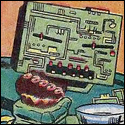|
Mister Sinewave posted:
|
|
|
|

|
| # ? May 8, 2024 11:20 |
|
Can someone explain to me what happens when one of the extruded plastic 3D printers does when it gets to an overhang? I'm looking at some ultimaker prints and it looks like they have had to print onto almost nothing. Am I crazy or is there something i'm missing? I know about support structures but every once in a while people seem to not use it even when there are overhangs.
|
|
|
|
Claes Oldenburger posted:Can someone explain to me what happens when one of the extruded plastic 3D printers does when it gets to an overhang? I'm looking at some ultimaker prints and it looks like they have had to print onto almost nothing. Am I crazy or is there something i'm missing? I know about support structures but every once in a while people seem to not use it even when there are overhangs. Well, if the angle isn't too steep it'll print fine without support. This model, for example: http://www.thingiverse.com/thing:12108 After that, unless you've enabled support structure ahead of time, the plastic will simply droop. The print can actually recover after a few layers as the amount of droops increases (creating a platform to build on), it's just that afterwards you'll have some cleanup to do. For example, on this beethoven model, there's always a stray loop under his shirt ruffles and usually a septum ring when scaled up: http://www.thingiverse.com/image:18707
|
|
|
|
I'm considering getting a 3d printer, perhaps a Prusa or similar. However, coming from an engineering background I can't help but feel that the mechanical components typically being used are extraordinarily flimsy. Is this a problem in practice? Does the print quality suffer from using threaded rods and plastic joints? Do you have to do a lot of time-consuming realignment if the print head runs into the table or a printed model? Also, the machines typically have an Arduino board - how is the workflow organized? I'm thinking you compile some Gcode on a pc and push it to the Arduino via USB or whatever, and then the Arduino controls a passive stepper drive board? Are there anyone running a pc with mach3 (or similar) instead of the Arduino?
|
|
|
|
Someone mentioned a prusa or something made with uni-strut, that sounds like it'd be stiff enough, as for the rest of the components you can replace them with better as you go along. I've love an ultimaker & would probably want to replace the plywood sides with something else later, if only to extend the z-range.
|
|
|
|
Astrolite posted:I'm considering getting a 3d printer, perhaps a Prusa or similar. However, coming from an engineering background I can't help but feel that the mechanical components typically being used are extraordinarily flimsy. Is this a problem in practice? Does the print quality suffer from using threaded rods and plastic joints? Do you have to do a lot of time-consuming realignment if the print head runs into the table or a printed model? In general, the reprap is more than strong enough. The prusa, as opposed to the original mendel achieved much of its popularity from being much faster to print, and faster to assemble. The former was done largely plastic from its printed bits, making them flimsier. In come cases they went too far, but most of them have been adjusted back up to where it needs to be for sufficient rigidity. The original mendel is also a large step back in rigidity from the darwin model, which had much more cross bracing. You have to remember that opposed to CNCing, the tool head loads are very low in printing, the biggest causes of deflection in 3d printing at these scales is the acceleration of the print head. Larger printers do have issues with deflection from weight, but those are 2-3 times the size. Such larger printers have typically gone to t-slot extruded aluminium for greater stiffness. There has been some effort to make smaller printers out of t-slot to increase the ability to withstand higher acceleration. At this point its pretty much the minimum for reasonable stiffness for the current size. There is some argument to the idea that the current used geometry is just defective in terms of which axises its actually stiff in. But that's a whole other topic. Because of the nature of 3-d printing, the print head almost never hits the model or the print bed. That sort of calibration is basically a snap too. Adjust the print head to be almost touching the bed (like paper width close), and run a calibration routine. Similar routines are for other moving bits. There are other calibrations, like steps per MM wrong, and you need to experiment a bit by printing off a cube. But after you get that right, its almost constant over the life of the machine. The ARE calibration issues whenever you put new filament into the machine, and they can be a pain. Different colors need different heats, and due to tolerances the filament can vary in size enough to need calibration too. Workflow is basically download STL, run one of the host programs for your printer, which will slice it up and generate the G-code and download it to the printer. The stepper controllers are pretty much a single chip per motor. Some printers also have a SD card reader so you can download the Gcode to a sd card, and the arduino can read it off the SD card without needing to occupy a computer. All in all, you were pretty much right here. There some work done on mach 3 control. It's generally not considered an ideal fit for the problem space, but is mostly workable. All the work on it basically started because a cnc company got interested in it. They also are a plastic molder, and have put together a very aggressively priced kit (~$350 for everything but a mach 3 license), so if you're already familiar with such things it could be a very good way in. Aurium fucked around with this message at 23:13 on Jan 29, 2012 |
|
|
|
I really like the idea behind the Mendel90, building the simplest frame that keeps stiff along the correct axes. But it's still new enough that the designer, Nophead, is still tweaking it and as a result has not released the design yet. Also I just don't like the idea of working with wood. So my current favorite design is the Aluminum Mendel. It takes a similar approach to frame design as mendel90, but uses aluminum extrusion instead. So this aluminum mendel has replaced the MendelMax forb my "What printer I'd like to build next as soon as I have money again." I feel like it's simply the most logical, elegant design at the moment.
|
|
|
|
peepsalot posted:I really like the idea behind the Mendel90, building the simplest frame that keeps stiff along the correct axes. But it's still new enough that the designer, Nophead, is still tweaking it and as a result has not released the design yet. Also I just don't like the idea of working with wood. MDF, not wood. Yes, MDF is composed largely of wood, and most of the rest is glue. Of course fiber plus binder is pretty much the description of any composite material. If you're really concerned, acrylic sheets are always an option, and has some nice aesthetics. Aluminum Mendel is a pretty good arrangement, but it falls into the same idea of simply substituting a stiffer material*, rather than a more intelligent arrangement of forces. Arranging the panels of MDF in parallel with the forces that panel opposes allows you to take advantage of cubic stiffness gains from increased length even from a very inexpensive and easy to deal with material. Admittedly the tslot beams do have much more material in plane than threaded rod would. *so much stiffer that reducing the vertical bracing, as opposed to the mendelmax, is pretty reasonable idea
|
|
|
|
Personally I'm going with the MendelMax because it seems to have the right ratios of performance, ease-of-construction, established contributors, proven ability and prusa cross-compatibility. Looking through the parts catalogues for some of the extrusion producers though, I'm seeing some real possibilities for inexpensive t-slot frames with ridiculous rigidity and relatively low cost. This stuff has been developed by automated industry since the 70s, the array of accessories and options is incredible. The holy grail for me would be frame rigid enough for a hybrid printer/light-use router. A machine that could print a prototype part with a bit of excess and clean up/drill precise mounting holes and edges with a small router bit. MDF is an extremely stable material, even at relatively high humidity - its great, but on a personal level I think it looks cheap as hell, especially when it gets a few knocks and scuffs. For slightly more dollar you can get a much more durable, aesthetically pleasing result out of laser cut polycarb sheet.
|
|
|
|
Looks like both my Shapeways and Ponoko orders are shipped; Ponoko was a couple days or so faster. Since it's UPS (standard I assume) it'll be a week or so for them to get to me. Can't wait to find out how I hosed up the models I requested!
|
|
|
|
Learning G-code at the moment, and I was wondering what does 3d-extruder code look like. I've understood that is what most of these printers use, please correct me if I'm wrong. If someone would happen to have a short full code for a part could you post it/copy it to pastebin?
|
|
|
|
Here's gcode for a 10mm cube if that's what you're after. No raft or anything fancy, though of course there are commands for turning on the heaters, etc. The outside surface is solid but the inside of the cube is a grid "honeycomb" pattern. http://pastebin.com/XpxvJ7NC
|
|
|
|
beta posted:Learning G-code at the moment, and I was wondering what does 3d-extruder code look like. I've understood that is what most of these printers use, please correct me if I'm wrong. If someone would happen to have a short full code for a part could you post it/copy it to pastebin? Yeah, the Arduino firmware is basically a barebones G-code interpreter: http://reprap.org/wiki/G-code#RepRap_G_Code_Fields Though that got me wondering: How hard would it be to turn it into a fully featured interpreter, one usable for a hobbyist-level mill or lathe? Most hobbyist CNC machines are still stuck with serial ports (absent from drat near every motherboard made in the past few years), and what few USB CNC interfaces there are cost quite a bit.
|
|
|
|
Cockmaster posted:Yeah, the Arduino firmware is basically a barebones G-code interpreter: Actually, the 3d printing firmware Marlin takes its acceleration handling code from grbl supposedly. There may be other firmwares doing the same.
|
|
|
|
There's already work happening on a GRBL shield for the Raspberry Pi - a new embedded linux dev board. Which knocks seven shades of poo poo out of the 2560 Mega in cost, features and capability. Basically it's an arm core machine running linux with HDMI, USB, ethernet, SDHC and other IO for $25.
|
|
|
|
Mister Sinewave posted:Here's gcode for a 10mm cube if that's what you're after. No raft or anything fancy, though of course there are commands for turning on the heaters, etc. Hmm, interesting. There are similarities, but the code for makerbot is a tad harder to read than mill/lathe code for a Fanuc controller. Ton of simple G1 movement on the makerbot. Might be a matter of getting used to it I guess. Here's a sample of a milling code for Fanuc 6m: http://pastebin.com/UiMNL4fn 
|
|
|
|
Cockmaster posted:and what few USB CNC interfaces there are cost quite a bit. The machine I bought came with one of these controllers http://www.planet-cnc.com/ Works pretty well and isnt hugely expensive.
|
|
|
|
ReelBigLizard posted:There's already work happening on a GRBL shield for the Raspberry Pi - a new embedded linux dev board. Which knocks seven shades of poo poo out of the 2560 Mega in cost, features and capability. Running linux isn't really a good thing here. Things like machining really should be backed by a hard realtime OS. With soft guarantees, and only 700mhz, I'm no sure its a good solution without external buffering hardware. There are realtime linuxes available, such as RTLinux. All in all you're talking about more work to get the hard scheduling that a bare microcontroller gets out of the box. In the world of physical computing, there's also a bit of a false economy going here. The Raspberry Pi has very little general purpose I/O on it and no ADC. My projects have never used ethernet or a monitor display. On the other hand, they use lots of digital and analog input. For a Raspberry Pi you'd have to buy a general I/O board to do that kind of thing, which is estimated at something like $20. Which pushes it back into the Arduino range, and above the 3rd party clones. I'm not saying it's a bad project by any means, I'm saying its a hammer, and many of these problems are screws, not nails.
|
|
|
|
Yeah moving away from arduino to ARM processors is going to kick rear end. There's lots of work being done currently on new board designs and firmware. Smoothie firmware looks promising: http://smoothieware.org/ This would run natively, not on top of Linux, as far as I understand. I hope to run it on a 4pi when it's ready, but the board is still in testing phase at the moment. I think in the future these fully integrated boards (stepper drivers and everything else on a single board with no "shields") are going to win out over using arduino(6 circuit boards total!). At least in the reprap world. They have the possibility to provide much better economies, and better heat management than the pololu boards alone. Raspberry pi looks like it's going to be an amazing platform, I really want one to replace my XBOX1 running XBMC. But I don't feel it is well suited as a controller for 3d printing.
|
|
|
|
Officially petitioning for a thread title change: Measure with Micrometer, Mark with Chalk, Cut with Axe - the 3D Printer Megathread!
|
|
|
|
My Ponoko order arrived. I used "3D Printed Durable Fine" material. It's kind of mint-candy green colour. Very smooth. Some line-like artifacts visible on a couple sides if you look closely. The face is really really smooth. Dimensions are right on. It was well-packed. It stinks, with a sort of solvent-ish smell (I expect it will outgass after a while.) It looks great. It feels just a little bit "grabby" in that way grippy plastics do. This little thing cost just over 50 bucks all told. My Makerbot-style 3D designing does a good job playing to my Makerbot's strengths, but there's a lot of fat that could be trimmed - especially since you pay by volume. (Note: the hole on the left has just been drilled out, which I did before I remembered to take a picture.) Ponoko (USA) was pretty easy to use. They finished my order a couple days ahead of Shapeways. Still my Shapeways order (from Europe) was somewhat cheaper and should be here later today - so basically almost the same turnaround time in the end. Click should you need to see it closer. 
The Eyes Have It fucked around with this message at 21:46 on Feb 1, 2012 |
|
|
|
Mister Sinewave posted:Officially petitioning for a thread title change:  I don't get it. I don't get it.
|
|
|
|
peepsalot posted:
1. Make sub-millimeter accurate models with a computer 2. Export to printing hardware which is made from bendy stuff with a print head that is to your computer model what a pipette is to an inkjet 3. Print with a material that warps and shrinks as it cools e: Home 3D hobby printing is like a gross, physical example of the concept of significant digits.
|
|
|
|
I print with PLA, doesn't really shrink from all I've seen. My prints are easily sub millimeter accuracy. I literally measured a nut the other day with dial calipers, printed out a part with exact size nut capture, and press fit perfectly with no post processing. Edit: By the way, it was this blue piece I designed to hold my spool together  http://www.thingiverse.com/thing:16758 peepsalot fucked around with this message at 22:21 on Feb 1, 2012 |
|
|
|
Thread titles like that are kind of intended to be humorously self-deprecating, but whatever; it seemed funny to me at the time for a variety of reasons but I might be alone on that one.
|
|
|
|
No, it's funny; peepsalot just wants to argue. 
|
|
|
|
I dunno, maybe I'm just a humorless jerk, but when the guy that only ever talks about sending off his 3d models to commercial printers in a DIY thread just wants to emphasize how lovely hobby printers are, I guess it kinda struck a nerve.
peepsalot fucked around with this message at 23:31 on Feb 1, 2012 |
|
|
|
Mister Sinewave posted:(Note: the hole on the left has just been drilled out, which I did before I remembered to take a picture.) This is surely obvious to everyone but me, but why not make the model with the hole already there?
|
|
|
|
peepsalot posted:I dunno, maybe I'm just a humorless jerk, but when the guy that only ever talks about sending off his 3d models to commercial printers in a DIY thread just wants to talk about how lovely hobby printers are, I guess it kinda struck a nerve. That's a lot to lay at my doorstep, considering it's not even truthful.  Same Great Paste posted:This is surely obvious to everyone but me, but why not make the model with the hole already there? No, you're right. I still have an incoming model that has all the holes to the proper dimensions. I just had no idea how accurately the holes would be made by the fab house, so I played it safe and made that hole a little too small so I could drill it out to the proper exact size easily - partially because that hole in particular has to be exact, and partially to see how well the print material could be drilled. Fake edit: I just received the alumide print from Shapeways.  It's pretty cool. Super rigid and SHARP edges and detail. It's like a cross between a cinder block and an eraser, or something. It's pretty cool. Super rigid and SHARP edges and detail. It's like a cross between a cinder block and an eraser, or something.
|
|
|
|
peepsalot posted:Yeah moving away from arduino to ARM processors is going to kick rear end. There's lots of work being done currently on new board designs and firmware. Arduino isn't a processor, its a platform. It currently happens to use the Atmel's AVR processors, instead of ARM processors. There are plans for the Arduino Due which will be an ARM based arduino. If it will get traction, either in reprap or overall remains to be seen. peepsalot posted:Smoothie firmware looks promising: http://smoothieware.org/ Another board to look out for is the R2C2, it's shown itself to run at some pretty good speeds. That said, there are some barriers to fully integrated boards. First off, repraps have frequently been evolving projects, today's fully integrated board is tomorrow's half a board with another board providing new functionality. Partially integrated boards have this same issue, but they don't use full integration as a selling point. Another is that fully integrated boards typically fix you to a single CPU's with a set of limits, the Sanguinololu is a relatively early example of a rather highly integrated board, and it's cpu has almost no headroom left in either GPIO or space for more featureful firmware. A daughter board allows the possibility of simply attaching it to a more advanced micro controller setup. Basically there a good chance that the RAMPS will work with the Arduino Due when it comes out, which may increase it's longevity. Another one is that a fully integrated board basically implies manufactured. Reprap boards avoid SMD components when possible for ease of home assembly, when they do use them, it's almost always relatively large resistors and capacitors. Reprappers want kits to assemble, or even source themselves, to save money. Gen 7, for example uses no SMD components what so ever. Processors with reasonable capabilities are all SMD, with many many tiny close together leads. USB to UART is almost always SMD. Stepper motor drivers are SMD, and so forth. To allow for this kind of thing, and still let home assembly be widespread, they basically abstract these devices as daughterboards, and just plug them in a socket, as though it simply was a single component. On the other side, we have things like the Gen 6 electronics. Professionally made, fully integrated, no daughterboards, no sockets, lots of SMD. Difficult to make at home. It's a pretty good solution that is completely integrated, if it has a fault, it's that it's the same low on headroom CPU as the popular Sanguinololu. The Gen 6 is not very popular. Why? Because only one set of people make it. It's designed to be professionally made, and not many outfits that make that kind of item wish to go into such a focused product. Instead they make the microcontroller boards that go into anything. They make the stepper motor breakout boards. And so forth. For those that do wish to make a board especially for reprappers, they'll make something that they know is popular. It may get to tightly integrated boards, but while it has its benefits it's actually cross purposes to what many people are actually working.
|
|
|
|
Mister Sinewave posted:That's a lot to lay at my doorstep, considering it's not even truthful. Here, have a pic of some stubby screwdriver handles   I thought this design was a pretty cool idea and you can fit a buttload on a single plate. Could make a neat giveaway item I think. The commercial one in comparison uses non-standard size bit shank, and the largest phillips bit is too fine of a point for most screws anyways.
|
|
|
|
peepsalot posted:I'm sorry, you're right. I'm just having a lovely day and being an rear end in a top hat for no reason. I'm going to shut up about the serious business of thread titles now. I love those! I have no reason to print one for myself, but I might make one for the shop just in case.
|
|
|
|
peepsalot posted:I'm sorry, you're right. I'm just having a lovely day and being an rear end in a top hat for no reason. I'm going to shut up about the serious business of thread titles now. With a little modification, those would be pretty awesome for ye olde makerspace. Just add the name on one of the side of the model before you print it off. While we're looking at cool things we've recently found, how about a printable lathe?
|
|
|
|
What's the price difference between printing on your own machine compared to sending it to a 3D printing company for printing? For fine detail work it seems it would cost about 2.50 per cubic centimetre for a professional shop to print it, which is pretty pricy for what I have in mind and I'm curious how much cheaper you could get it for if you had your own machine (roughly). Sorry if this is a common question.
|
|
|
|
  S'cool S'coolLooking at my post history, it's true I have been pretty free with bringing up frustrations at the devices' shortcomings. But I really do think they are fascinating devices, and it's amazing to be able to have a computer -> physical object pipeline right at my workbench. I've also embraced using my DIY printer - along with 3D designing parts - into my own professional workflow. But it is frustrating to run into limitations that keep it's role in my workshop limited to niche tasks (or novelty work).  peepsalot posted:
|
|
|
|
InternetJunky posted:What's the price difference between printing on your own machine compared to sending it to a 3D printing company for printing? Printing on your own machine is basically pennies (in material). If you don't count the cost of the machine itself, maintenance, parts, time for operation, etc. Printing from a fab house is not cheap; too expensive IMO to use for anything more than niche items - stuff that can really only be 3D printed because it would be impossible to make by hand, or something. Here's three identical items. Two are professionally done, one is made from ABS on my DIY printer. There's really no contest between the three, but they are also deeply different from one another. Also the professionally fabbed ones are 40-50$ each. The home-printed one was probably, what, like maybe 0.15$ of plastic and I had it in my hands within an hour of firing up my printer. (The DIY printed one is black and doesn't photgraph for poo poo, sorry.)  It's hard to overstate how SHARP and CRISP the alumide one is. By the way, both my Shapeways and Ponoko orders arrived far earlier than I expected them to, I'm looking at a 2 week turnaround instead of like 3 which I expected. I retract my earlier hemming and hawing!
|
|
|
|
Mister Sinewave posted:Here's three identical items. Two are professionally done, one is made from ABS on my DIY printer. There's really no contest between the three, but they are also deeply different from one another. Also the professionally fabbed ones are 40-50$ each. The home-printed one was probably, what, like maybe 0.15$ of plastic and I had it in my hands within an hour of firing up my printer. It's pretty exciting to see this technology develop, and since I'm into a lot of detailed modelling my mind is racing with possibilities.
|
|
|
|
^^^ A mix of both, I think. ABS (which I used for my print) is the workhorse but PLA is what all the leading-edgers use and it is capable of better prints for a variety of reasons. Also there is bleeding-edge hardware and materials like that amazing cured resin printer built around a projector to cure the "slices". On a different note, this showed up in an article by pocketfactory.org which is a few guys on a road trip with a few hobby printers experimenting with demoing and selling stuff printed at coffee shops, flea markets, etc. I found this part in particular very interesting: quote:We might not be selling anything here in the flea market, but something very interesting starts happening. Flea markets are rife with entrepreneurial energy. Its the nature of the game - everyone sitting behind the tables next to us has a nose for business they're always thinking about what people want and how they can make a business out of it. I find it interesting because it's a whole different angle to the 3D printer thing.
|
|
|
|
Ordered my Replicator yesterday  Now to wait "approximately 6 weeks" Now to wait "approximately 6 weeks"Time to learn OpenSCAD!
|
|
|
|

|
| # ? May 8, 2024 11:20 |
|
fins posted:Ordered my Replicator yesterday Congrats / you bastard! Make sure you also check out the new OpenJsCad, which has variable support and is basically just really neat: http://blog.ponoko.com/2012/01/25/javascript-3d-modeling-with-openjscad/
|
|
|























